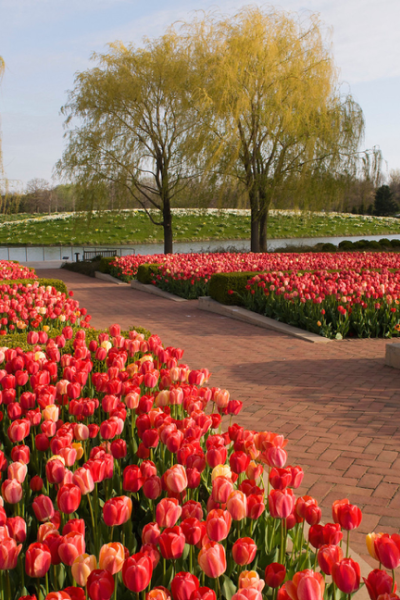
You might have a few in a pot. Or planted dozens in a flower bed. At the very least, you’ve seen swaths of them outside shopping centers. Wherever they appear, feathery daffodils come first, and they nearly always feel like a surprise.
The muted palette of winter suddenly brightens as tender green shoots emerge from the ground, topped with pops of color: sunny yellows, bridal-gown whites and light yellows with centers that look as orange as an April sunset.
Tulips come next, as long as the deer don’t eat yours the way they gobbled mine to the ground two weeks ago. Then azaleas. Then crabapples. Then redbuds. This rhythm of spring is what makes Chicago Botanic Garden in Glencoe, Morton Arboretum in Lisle, and Allerton Park in Monticello some of the best places to watch spring unfurl—and not just because their enclosed spaces keep out the nibbling deer. At each place, horticulturalists work year-round to ensure that when you visit, you’ll take in the most beautiful blooms at precisely the right time.
Spring is a spectacle I am particularly drawn to this year. Doctors at two of the world’s best cancer centers told me I wouldn’t live to see this spring. Acute myeloid leukemia has a way of doing that. But here I am, 43, in remission after more than two years of chemo and a bone marrow transplant last winter.
These days, springtime in Illinois reminds me of a quote from The Fault in Our Stars: "I fell in love the way you fall asleep—slowly, then all at once." This year, after a snow-free January, a warmer-than-usual February and a lion-like March, springtime started, then slowed, then slammed on the gas. I want to make time to watch it unfold. And I bet I’m not the only one.

See a Color Show
SPRING BLOOMS AT CHICAGO BOTANIC GARDEN
When they bloom in the wild, the soothing blue petals of Siberian squill announce their arrival with a sweet smell—one you might notice during a visit to Chicago Botanic Garden in the city’s far northern suburbs. There, too, rich red tulips on raised beds that roll out like a carpet toward the Crescent Garden's North Lake. These tulips number about 26,000, a figure that seems impossible to an amateur grower like me—until I learn that the entire garden nurtures more than a million bulbs every year.
But tulips are just the early starters of the springtime color show. In the Malott Japanese Garden, azaleas stand atop a hillside and point their pink-purple faces toward the walking path below. White pompons of fragrant viburnum look playful to me on their bushes; I especially love the blossoms tinged with lightest pink at the center.
Meanwhile, a fiery red cardinal rests on a white birch tree, looking a little huffy that he’s not the star of the color show. Guided seasonal walks can help orient you through the 385 acres, and special flower shows, like the Midwest Daffodil Society Show (April 29–30), give you a chance to see these gorgeous plants in more varieties than you could have imagined. I’d never seen a white daffodil with a light-pink trumpet in the center, or a cream-color blossom that looks like a miniature rose. My eyes widen as I watch, grateful for the chance to experience it all.

Wander in the Woods
WILDFLOWERS AMONG THE TREES AT MORTON ARBORETUM
In west suburban Lisle, big, blooming trees and the tiniest wildflowers at Morton Arboretum work in tandem to pull your view back and forth from the ground toward the sky. Queue up Alanis Morissette on the irony: it seems like the faster the blooms evolve, the less I have to pace myself to take it all in. That works for me, since I also have multiple sclerosis and need a motorized scooter to get around big places like this (hello, 1,700 acres of prairie, woodlands and gardens!). How else could I enjoy the fields of yellow flowers in the Daffodil Glade, or the clusters of redbud trees, their sturdy limbs nearly choked with thick pink flowers. (I actually ate redbud blossoms a few years ago—they taste kind of nutty.)
Until now, I hadn’t seen the arboretum during the spring. My visits always somehow happened during the fall, when I could drive 20 minutes from my apartment in Downers Grove for an easy, yellow-red-orange foliage fix amid the busy suburbs. So I never knew about the showy white-pink magnolias by the Visitors Center (just one of the 49 kinds at the arboretum—look for a lot more on the East Side), or the white pear blossoms, or the pink Cornelian-cherry dogwood blossoms.
If you crave a little activity with your spring blooms, consider the Champion the Trees 10K run on April 23 or family-friendly projects on Arbor Day, April 28. Otherwise, do as I do and pick a slow day, char


Get a Taste of Two Worlds
NATURE MEETS ART AT ALLERTON PARK
If I didn’t know any better, I’d think that Allerton Park in Central Illinois competes with itself for the best springtime show. On the one hand, it has the gorgeous, 32,000-square-foot Georgian manor house and perfectly symmetrical gardens dotted with Chinese and European sculptures. That’s the Allerton Park I knew as a graduate student at the University of Illinois at Urbana-Champaign, which owns the estate. It’s formal. Deliberate. Classy.
But that’s just part of this more than 1,500-acre estate. Six of the seven hiking trails lead through the park’s wild side: thick oak woodlands, where white mayapples and delicate Virginia bluebells pepper the forest floor weeks before the oak/hickory trees above them start budding. Other trails wind through lowland forests full of ash, maple and sycamore trees and up to bluffs overlooking the Sangamon River, which runs through the park.
Another trail runs alongside the river itself. The formal gardens and the hiking trails could feel like a weird mash-up—until you learn about the park’s founder, Robert Allerton, an artist who drew his inspiration from nature.
This spring, Allerton Park has a third annual event that beautifully fuses both types of experiences. At the Forest-to-Mansion Dinner on May 7, five local chefs create dishes using morels, ginger and other wild plants from Allerton Park and serve that meal in the mansion’s splendor. I’ve already checked out the menu online. My appetite isn’t what it used to be, thanks to everything I’ve been through. But the dishes sound so good, especially the wild Allerton ramp gnocchi with smoked lamb shoulder and fried morels. (That event may be your best chance to taste the park's wild plants, as foraging is not allowed at Allerton Park.)
As it turns out, the spring I was never supposed to see has instead awakened all my other senses, too.
Two More Ways to See Spring in Illinois
These gardens are hardly the only places to celebrate spring blooms. Check out these spring festivals around Illinois.
Dogwood Festival, Quincy
Block parties, a spring homes tour showcasing this community’s impressive architecture, amusement rides and a lively parade are just a few of the highlights of this Mississippi River town’s annual celebration, set for May 5–6. Dogwood trees blooming in pink, red and white line the parade route.
Lilac Time Festival, Lombard
The annual festival in Chicago’s western suburbs runs May 6—21, 2017, and the wildly popular parade on the final day draws thousands. You can take heritage tours through the historic Lilacia Park, which has 700 lilacs, as well as taste wine and beer, shop for handcrafted lilac wares in The Country Store, and walk in the Lilac Mutt Strut 5K and Puppy Path.
Share your Moments
#EnjoyIllinois



